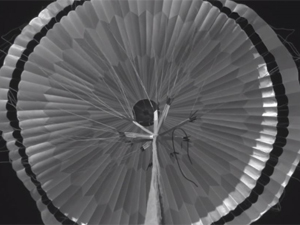



Date:30/10/18
 The Mars 2020 parachute is a go after NASA broke the record for the fastest inflation in history of a parachute that size early in September.
The Mars 2020 parachute is a go after NASA broke the record for the fastest inflation in history of a parachute that size early in September.
The third ASPIRE test took place in the early hours of September 7, when the 180-pound parachute billowed out form being a solid cylinder to full inflation in four-tenths of a second. The peak load of the nylon, Technora and Kevlar parachute reached almost 70,000 pounds of force during the test.
NASA launched a 58-foot Black Brant IX sounding rocket to Mach 1.8 to fully test the chute, which will play an integral part in landing the state-of-the-art Mars 2020 rover on the planet in February 2021. The part is so important that the Jet Propulsion Laboratory set up the Advanced Supersonic Parachute Inflation Research Experiment (ASPIRE) project to evaluate the options.
ASPIRE started out with an exact copy of the parachute that successfully landed Curiosity on the Red Planet in 2012 and then reinforced it with stronger materials and stitching. After the third test in September, the team determined the chute was ready after meetings earlier this month.
"Mars 2020 will be carrying the heaviest payload yet to the surface of Mars, and like all our prior Mars missions, we only have one parachute and it has to work," said John McNamee, project manager of Mars 2020 at JPL, in a statement.
"The ASPIRE tests have shown in remarkable detail how our parachute will react when it is first deployed into a supersonic flow high above Mars. And let me tell you, it looks beautiful."
The tests actually took the parachute to greater heights than the team ever expect it to reach on the Mars mission. The 67,000 pound load was the highest ever survived by a supersonic parachute and nearly 85% more than the load expected during deployment on Mars.
"Earth's atmosphere near the surface is much denser than that near the Martian surface, by about 100 times," said Ian Clark, the test's technical lead from JPL. "But high up – around 23 miles – the atmospheric density on Earth is very similar to six miles above Mars, which happens to be the altitude that Mars 2020 will deploy its parachute."
ASPIRE’s Record-Breaking Supersonic Parachute Is Ready For Mars 2020
 The Mars 2020 parachute is a go after NASA broke the record for the fastest inflation in history of a parachute that size early in September.
The Mars 2020 parachute is a go after NASA broke the record for the fastest inflation in history of a parachute that size early in September.The third ASPIRE test took place in the early hours of September 7, when the 180-pound parachute billowed out form being a solid cylinder to full inflation in four-tenths of a second. The peak load of the nylon, Technora and Kevlar parachute reached almost 70,000 pounds of force during the test.
NASA launched a 58-foot Black Brant IX sounding rocket to Mach 1.8 to fully test the chute, which will play an integral part in landing the state-of-the-art Mars 2020 rover on the planet in February 2021. The part is so important that the Jet Propulsion Laboratory set up the Advanced Supersonic Parachute Inflation Research Experiment (ASPIRE) project to evaluate the options.
ASPIRE started out with an exact copy of the parachute that successfully landed Curiosity on the Red Planet in 2012 and then reinforced it with stronger materials and stitching. After the third test in September, the team determined the chute was ready after meetings earlier this month.
"Mars 2020 will be carrying the heaviest payload yet to the surface of Mars, and like all our prior Mars missions, we only have one parachute and it has to work," said John McNamee, project manager of Mars 2020 at JPL, in a statement.
"The ASPIRE tests have shown in remarkable detail how our parachute will react when it is first deployed into a supersonic flow high above Mars. And let me tell you, it looks beautiful."
The tests actually took the parachute to greater heights than the team ever expect it to reach on the Mars mission. The 67,000 pound load was the highest ever survived by a supersonic parachute and nearly 85% more than the load expected during deployment on Mars.
"Earth's atmosphere near the surface is much denser than that near the Martian surface, by about 100 times," said Ian Clark, the test's technical lead from JPL. "But high up – around 23 miles – the atmospheric density on Earth is very similar to six miles above Mars, which happens to be the altitude that Mars 2020 will deploy its parachute."
Views: 344
©ictnews.az. All rights reserved.Similar news
- Azerbaijani project to monitor disease via mobile phones
- Innovative educational system to be improved under presidential decree
- NTRC prolongs license of two TV and radio organizations for 6 years
- Azerbaijan establishes e-registry for medicines
- Azerbaijani museum introduces e-guide
- Nar Mobile opens “Nar Dunyasi” sales and service center in Siyazan city
- International conference on custom electronic services held in Baku
- OIC secretary general to attend COMSTECH meeting in Baku
- Azerbaijan develops earthquake warning system
- New law to regulate transition to digital broadcasting in Azerbaijan
- Azerbaijani State Social Protection Fund introduces electronic digital signature
- Intellectual traffic management system in Baku to be commissioned in December
- Tax Ministry of Azerbaijan started receiving video-addresses
- World Bank recommends Azerbaijan to speed up e-service introduction in real estate
- Azerbaijan to shift to electronic registration of real estate





















